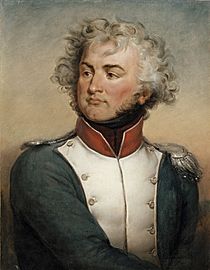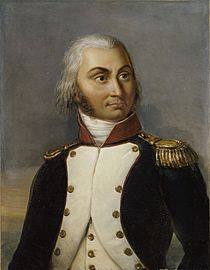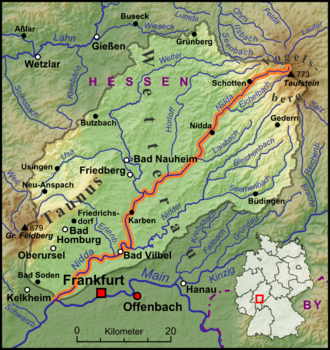Battle of Höchst (1795) facts for kids
Quick facts for kids Battle of Höchst (1795) |
|||||||
|---|---|---|---|---|---|---|---|
| Part of War of the First Coalition | |||||||
|
|||||||
| Belligerents | |||||||
| Commanders and leaders | |||||||
| Units involved | |||||||
| Strength | |||||||
| Campaign: 63,615 Höchst: 10,000 Niedernhausen: 5,000 |
Campaign: unknown Höchst: 5,500 Niedernhausen: 8,000 |
||||||
| Casualties and losses | |||||||
| Höchst: 500 Niedernhausen: 468, 5 guns Steinbach: unknown |
Höchst: 225 Niedernhausen: unknown Steinbach: 92, 3 guns |
||||||
The Battle of Höchst took place on October 11–12, 1795. It was a fight between the Austrian army, led by François Sébastien Charles Joseph de Croix, Count of Clerfayt, and the French Army of Sambre-et-Meuse, led by Jean-Baptiste Jourdan. Even though the French attacked first, they couldn't push back an Austrian group that was trying to go around their side. After this, Jourdan's army had to retreat north.
This battle was part of the War of the First Coalition, which was a bigger conflict during the French Revolutionary Wars. Today, Höchst is a part of Frankfurt am Main in Germany, about 12 kilometers (7.5 miles) west of the city center.
In 1795, the French used two separate armies to cross the Rhine River. The northern French army, under Jourdan, moved south after crossing the river. But the commander of the southern French army, Jean-Charles Pichegru, didn't cooperate well. This allowed the Austrian commander, Clerfayt, to move most of his forces to fight Jourdan. Clerfayt crossed the Main River to the east, putting his army in a risky spot on the French left side. After being stopped at Höchst, the French pulled back north. They eventually left the east side of the Rhine completely. Important battles that followed were the Siege of Mannheim on October 19 and the Battle of Mainz on October 29.
Why the Battle Happened
In the fall of 1795, the French government, called the French Directory, ordered two of its generals to attack across the Rhine River. General of Division Jean-Baptiste Jourdan and his Army of Sambre-et-Meuse were to attack in the north near Düsseldorf. At the same time, General of Division Jean-Charles Pichegru and his Army of the Rhine and Moselle could attack anywhere in the south. Their plan was to trap the defending Austrian army, led by Feldmarschall Count of Clerfayt, in a pincer movement.
Between these two attacks, the Siege of Mainz was still going on. French troops, led by General of Division Jean Baptiste Kléber, had surrounded the Fortress of Mainz since December 1794. However, the French didn't have enough heavy cannons to break through the city's defenses. Also, they couldn't fully surround the city because the Austrians still held the east bank of the Rhine.
On September 8, 1795, Jourdan's army successfully crossed the Rhine north of Düsseldorf. By September 20, his army had moved south to the Lahn River. French troops, led by General of Division François Joseph Lefebvre, surrounded the Bavarian soldiers in Düsseldorf. The Bavarian commander, Count Hompesch, surrendered the city on September 21. The 2,000 Bavarian soldiers were allowed to go home, but the French took control of Düsseldorf and its 168 cannons.
Because Jourdan's army was advancing, Clerfayt started moving his Austrian army north to stop them. This gave Pichegru a chance to act. Even though the city of Mannheim had a large Bavarian army of 9,200 soldiers, Baron von Belderbusch handed it over to the French after talks. The Austrians were very upset with their Bavarian allies, but they couldn't stop the French from getting this important crossing point.
The 1795 campaign showed a change in how French generals and the government worked together. After the Committee of Public Safety lost power in July 1794, the government's control over army generals became weaker. For example, when a government official tried to interfere with troop movements in September 1795, General Lefebvre simply ignored him.
When Mannheim fell, Pichegru had a chance to capture Clerfayt's supply base at Heidelberg. If he had done this, the Austrian general might have been forced to retreat. Instead, Pichegru only sent two divisions to take the town. When these two French divisions advanced with the Neckar River between them, Austrian Feldmarschall-Leutnant Peter Vitus von Quosdanovich gathered most of his troops against one of the French divisions. On September 24, Quosdanovich's 8,000 men defeated 12,000 French soldiers at the Battle of Handschuhsheim. The French had to retreat back to Mannheim.
After this, Pichegru and Jourdan discussed a plan to push the Austrians out of the area. Jourdan wanted to bring both French armies together near Mannheim. This would place them between Clerfayt's army and another Austrian army coming from the south. Jourdan hoped to defeat the Austrian armies one after the other. However, Pichegru disagreed with this plan, and both generals waited for new orders from Paris. While they waited, Clerfayt moved his Austrian army south to stop Pichegru from attacking his Heidelberg base. In response, Jourdan ordered his army to move south to the Main River. This move completely surrounded Mainz from both sides of the Rhine.
The Battle Itself
By October 1, 1795, Jourdan's Army of Sambre-et-Meuse had about 63,615 soldiers ready for battle. Some of his divisions were guarding areas behind the front lines, like Düsseldorf, Luxembourg City, and Aachen. Other troops were besieging the Ehrenbreitstein Fortress near Koblenz.
Jourdan's main army was spread out. For example, General Jean-Baptiste Bernadotte's soldiers were watching Kassel on the east side of Mainz. General Jean Étienne Championnet's troops were guarding the west side of Mainz. Other divisions were positioned along the north bank of the Main River, stretching for about 31 kilometers (19 miles).
Meanwhile, another Austrian army arrived in the area. By October 10, it was near Mannheim. Since Pichegru wasn't putting pressure on him, Clerfayt could focus on Jourdan's army alone. He moved his army northeast to Aschaffenburg, then northwest to Offenbach am Main. Ignoring the neutrality of Frankfurt, Clerfayt's troops crossed the Main River. They went around the east side of Frankfurt and moved west along the south bank of the Nidda River.
On October 11 and 12, 1795, about 10,000 French soldiers, led by Kléber, tried to defeat an Austrian force. This Austrian force was defending the Nidda River line where it met the Main River. The 5,500 Austrian defenders, led by General-major Adam Boros de Rákos, held their ground. They included various infantry and cavalry units. Despite repeated French attacks, Boros's men stood firm. The French lost about 500 soldiers killed and wounded, while the Austrians lost 24 killed and 201 wounded.
After this, Jourdan held a meeting with his generals. They decided to retreat back across the Rhine River. On October 13, at Niedernhausen in the Taunus hills, the Austrians attacked the French rear guard. This group of 5,000 French soldiers was led by Generals Louis Klein and Charles Joseph Boyé. They faced about 8,000 Austrians. The French force was scattered, losing 334 killed and wounded, 134 missing, five cannons, and 111 wagons. The Austrian losses are not known.
Two days later, the French had a better outcome in another rear guard fight at Steinbach. A part of Clerfayt's Austrian force was driven away by the rear guard of General Lefebvre's division. The Austrians lost 92 soldiers and three cannons. French losses are not known. Instead of chasing the French aggressively, Clerfayt kept most of his army behind the Nidda River for five days after the battle. The French army retreated in different directions: the left side went to Düsseldorf, the center to Bonn, and the right side to Neuwied. The retreat of the right side was interrupted when the Neuwied bridge burned on October 19. By this time, Clerfayt decided to focus his efforts on the French forces at Mainz.
What Happened Next
The French retreat meant that General Marceau had to stop his siege of Ehrenbreitstein on October 17, 1795. His troops included several infantry and cavalry units. The Ehrenbreitstein fortress had a garrison of about 2,600 soldiers. Not many soldiers were lost on either side during this siege.
By October 20, the Army of Sambre-et-Meuse was back on the west bank of the Rhine River, with its main force around Koblenz. At the same time, the Austrian general Wurmser had started attacking the French-occupied Mannheim. With the two French armies now far apart, the French at Mainz had no support. Clerfayt launched a strong attack on the French lines and won the Battle of Mainz on October 29.
Then, Clerfayt turned south to fight Pichegru. The Austrian commander defeated the French at the Battle of Pfeddersheim on November 10 and at Frankenthal on November 14. These victories isolated Mannheim. The Austrians successfully ended the Siege of Mannheim on November 22, taking control of the city.
The French army's poor performance was partly due to General Pichegru's actions. He did not cooperate well with Jourdan and made choices that hurt the French effort. Even though there were reasons to be suspicious of his loyalty, he remained in command of the Army of Rhin-et-Moselle until March 1796, when he resigned. He was replaced by General of Division Jean Victor Marie Moreau.




